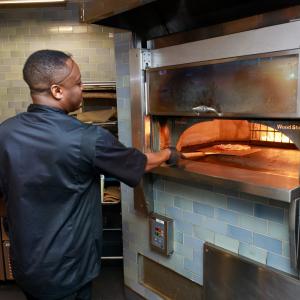
Internist Dr. Caren F. Behar is one of the NYU Langone doctors volunteering to staff hospital units during the coronavirus pandemic.
Photo: NYU Langone Staff
It had been 20 years since Caren F. Behar, MD, last worked in a hospital setting. But when the call came for NYU Langone doctors to help their colleagues by volunteering during the 2019 coronavirus disease (COVID-19) pandemic, she knew her skills as an internist were needed.
Dr. Behar, who is also medical director at the Joan H. Tisch Center for Women’s Health, is working 12-hour shifts caring for people with COVID-19 at Kimmel Pavilion. “I love working in the hospital and having the opportunity to fulfill a need,” she says. “This has been one of the most rewarding things I have done in my career.”
While doctors are learning day-to-day how to combat COVID-19, physicians who have not done hospital rounds or worked in critical care in years are challenged with retooling overnight. Dr. Behar likened the experience to the early days of her residency, when she rotated through different units and there was so much to see and to learn. “It is humbling and exciting to feel like an intern again,” she says. “I’m working with other volunteer physicians and the hospitalists, doing admissions, discharges, and making rounds.”
“I’ve learned that COVID-19 in hospitalized patients is very different from what we see in the outpatient setting,” she adds. “I wanted to better understand the disease in patients across the spectrum of severity, and this experience has given me the opportunity to do so.”
For Dr. Behar, day one at Kimmel Pavilion was focused on learning NYU Langone’s treatment protocols for COVID-19, including which lab tests to order and medications to prescribe for this new disease. Patient care is focused on maintaining adequate oxygen levels in the blood and dealing with the consequences of infection and inflammation.
Helping people recover is only one part of the challenge. Another is helping them to feel less lonely. “These patients are in isolation, and they can’t have any visitors,” Dr. Behar says. “Some are in the hospital for many days to weeks, and the only people they see are covered from head to toe with masks, gowns, and shields. It can be frightening, and people get very lonely. I try to sit and take time to talk with them, for which they are grateful.”
Working in the hospital has improved her understanding of how to treat patients in her practice who have COVID-19 symptoms, from whom she fields daily emails and phone calls, in addition to scheduled video visits. She knows more about what medicines to prescribe and when to tell her patients that they need hospital care. The experience has also given her a renewed respect for her colleagues.
“People in every arena are stepping up,” Dr. Behar says. “Doctors, nurses, and other healthcare workers go to work every day without thinking twice about it. They put their lives at risk because that’s what we do, and that is very inspiring.”

